The best exercises for the treatment of degenerative disc disease (stenosis) and sciatic nerve pain at home. How to eliminate back pain and treat your sciatic nerve symptoms with stretches and exercises. Tips and advice from a doctor of physical therapy.
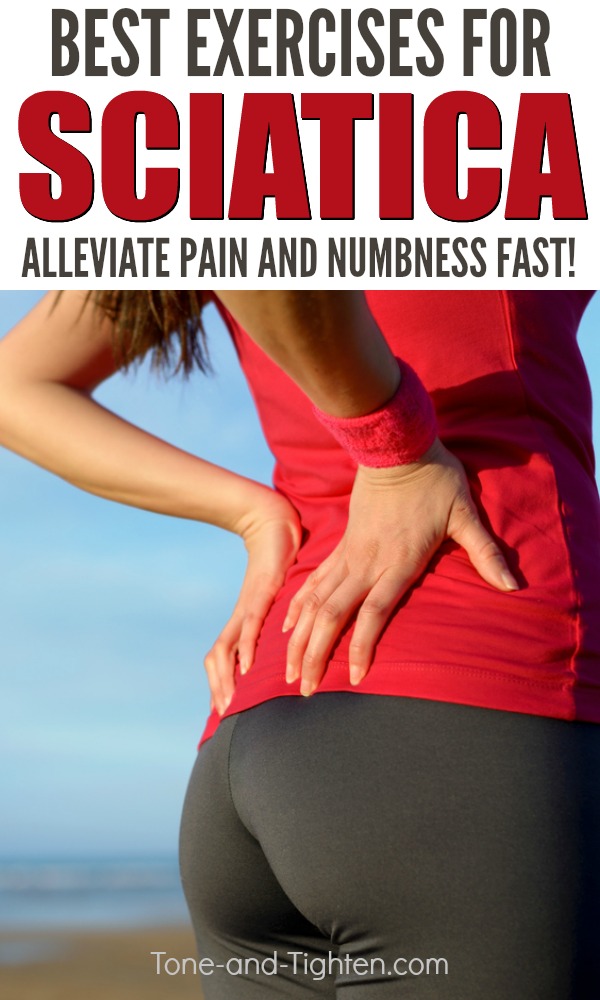
The most-common condition that I treat in my physical therapy clinic is lower back pain. It’s estimated that 60% of us experience a case of moderate to significant back pain at some point in our lives. If you haven’t experienced it firsthand, you probably know someone who has.
From muscles and joints to discs and ligaments, pain in your lower back can come from multiple sources. Depending on the source, back pain can also cause multiple symptoms including back pain, lower muscle weakness, and numbness and tingling.
We typically refer to leg symptoms that originate from lower back pain “sciatica”. This simply means an irritation to the sciatic nerve that causes pain, numbness, or tingling down into your leg(s).
For the purposes of this post today, I’ll be covering the signs and symptoms associated with one very specific type of low back pain – degenerative disc disease (or DDD), stenosis, and sciatic nerve pain. There’s a lot that the right stretches and core exercises can do to alleviate the symptoms associated with this condition and help you to feel better.
Now – it’s important to note that the exercises and stretches I’m demonstrating below are for one very specific type of back pain – disc degeneration or stenosis. For those of you who may be suffering from another common diagnosis – a herniated disc or a bulged disc with sciatic nerve pain/symptoms – I encourage you to check out this post that I did for the best treatment options for that pain: https://tone-and-tighten.com/how-to-treat-sciatica-best-exercises-for-sciatic-nerve-pain.html
WHAT IS DEGENERATIVE DISC DISEASE?
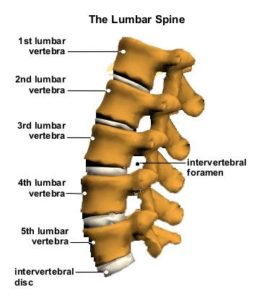
Degenerative disc disease (DDD) is not an actual “disease” – rather it refers to a condition that affects the discs between our vertebrae. The vertebrae of our spine are each separated by an individual “disc”. This is a cartilaginous structure that’s filled with an aqueous fluid that allows our spines to bend, twist, and absorb shock.
Over time, these water-based discs lose their ability to retain fluid and the disc height starts to decrease (or “degenerate”). Oftentimes this decreases mobility in our spines and causes pain/inflammation at the area of the degeneration.
WHAT IS STENOSIS?
As the disc collapses, intervertebral foramen (or “hole”) through which the spinal nerves exit our spine becomes narrower. This “narrowing” is referred to as stenosis. When the foramen becomes so narrow that the nerve becomes impinged this can be the cause of pain in our back and sciatic nerve symptoms (numbness/tingling/pain) down your back.
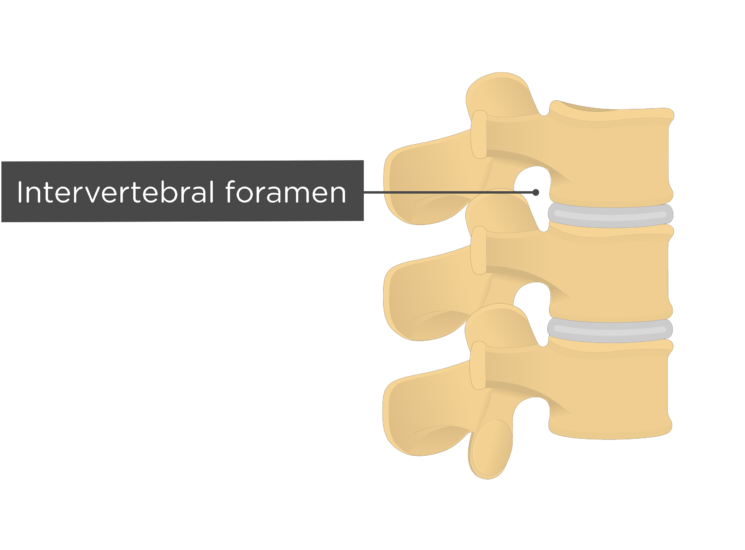
HOW DO I KNOW IF I HAVE DEGENERATIVE DISC DISEASE?
Some of the most-common signs of disc degeneration include –
-
Advancing age – degenerative discs usually start to show up in our 40’s and become more and more common with each generation of life.
- Gradual onset / no specific injury – you don’t typically get DDD and stenosis from bending, lifting, or twisting wrong one time. Rather it’s a gradual onset that worsens as you age.
-
Previous injury – if you’ve had back pain at any time in the past, chances are you’ve developed a “weak link” where back pain can set in.
-
Flexed spine positions are better than extended spine positions – typically individuals with degenerative discs prefer sitting to standing and walking. Reaching forward to touch your toes is generally preferred to bending over backwards and leaning over a shopping cart feels better than pushing it upright.
-
Symptoms can be posture-dependent: Symptoms are aggravated with upright postures and are typically alleviated when the person lays down.
Now that you know what this condition is and what causes it, let’s discuss some of the best home exercises for the treatment of degenerative disc disease and demonstrate some ideas to help you feel better.
HOW TO TREAT DEGENERATIVE DISC DISEASE
The goal of conservative exercise care in the treatment of DDD is to find a “midpoint” or “neutral zone” in your spine positioning that creates as much space between the vertebrae and in the foramen as possible. Just like bending over backwards causes these foramen to close, bending forward or “flattening out your back” causes them to open up.
If you do have DDD and lumbar stenosis creating more space in the vertebrae and foramen should help to feel better. However – If performing these exercises causes your pain to increase then that’s a strong sign that these are not the best exercise for your condition.
BEST EXERCISES FOR DEGENERATIVE DISC DISEASE
Here are the best exercises to open up and create more space in your intervertebral foramina (the “holes” through which your nerves exit out of your spinal cord). We want to stretch to open them up more and then strengthen in that position to maintain that space.
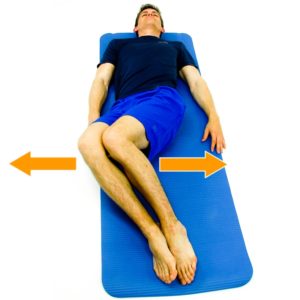 Side Rotations
Side RotationsLay on your back with your knees bent.
Rock both knees to the left until a comfortable stretch is felt on your right side.
Hold 10 seconds and repeat to the left.
5 times each direction.
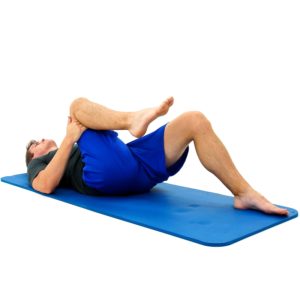 Single-Knee-To-Chest Stretch
Single-Knee-To-Chest StretchLay on your back with your legs out straight.
Bend your right knee into your chest and use your arms to pull it in closer.
Hold 20 seconds and repeat with the left leg.
3 times on each leg.
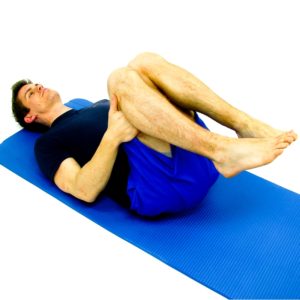 Double-Knee-To-Chest Stretch
Double-Knee-To-Chest StretchLay on your back with your legs out straight.
Bring both of your knees into your chest and use your arms to pull them in closer.
Hold 20 seconds. Repeat 3 times.
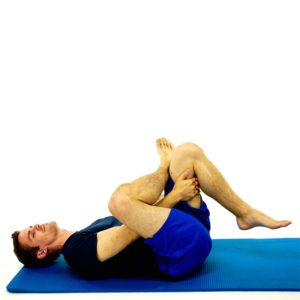 Piriformis Stretch
Piriformis StretchLay on your back with both knees bent.
Cross your right ankle over your left knee.
Wrap your hands around the back of your left thigh and pull it up towards your chest until a stretch is felt in your right buttocks.
Hold 20 seconds and repeat on the left side.
Repeat 3 times on each leg.
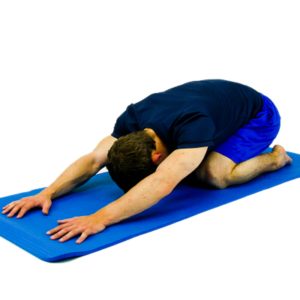 Child’s Pose
Child’s PoseGet down on your hands and knees.
Keep your hands on the ground and sit down on your heels until a stretch is felt in your spine.
Hold 20 seconds. Repeat three times.
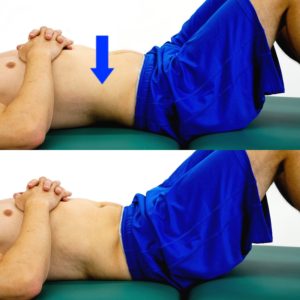 Posterior Pelvic Tilt (PPT)
Posterior Pelvic Tilt (PPT)Lay on your back with your knees bent.
Rock your hips backwards and push your lower back down into the floor (flatten your spine to the ground).
Hold 5 seconds and then relax. Repeat 10 times.
3 sets of 10 repetitions.
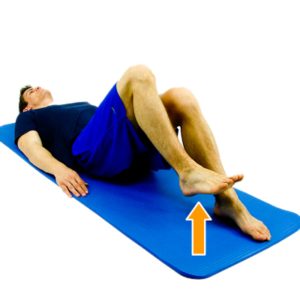 PPT with March
PPT with MarchGet into the posterior pelvic tilt position as outlined above.
Hold your back flat and your stomach tight as you alternate marching your right and left legs up off the floor.
10 marches on each leg; repeated 3 sets.
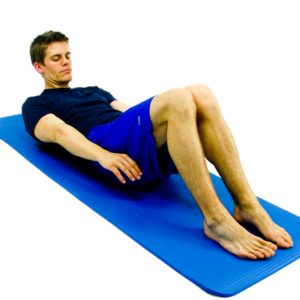 Crunch
CrunchLay on your back with your knees bent.
Reach your hands down towards your thighs.
Lift your shoulder blades up off the floor by sliding your fingertips to your kneecaps.
10 repetitions – repeated 3 sets.
Degenerative disc disease is a condition that affects millions of people. It can be a debilitating, painful condition, but fortunately there’s a lot that conservative care and physical therapy can do to help it! Regularly performing these exercises can help to ameliorate your low back and sciatic nerve pain and help you to feel better.
Interested in learning more? Check out some of these popular videos on our YouTube channel!
Be sure to SUBSCRIBE TO OUR YOUTUBE CHANNEL while you’re there!
For more great home fitness tips, workouts, and healthy eating advice, be sure to follow Tone and Tighten on YouTube | Facebook | Instagram | Twitter | Pinterest
Make it happen,
Jared
Disclaimer: The information presented in this post is designed to be used for informational purposes only. The diagnoses and treatment plans outlined are extremely generalized and may or may not be the recommended interventions for your specific problem. If you are experiencing pain, you are encouraged to consult a healthcare provider to determine the best treatment plan that will be in your best interest individual. Tone and Tighten and all its affiliations claims exemption from accident, injury, or perpetuation of any injury incurred while performing any exercise found on this website. The user assumes all risk … and reward!!
